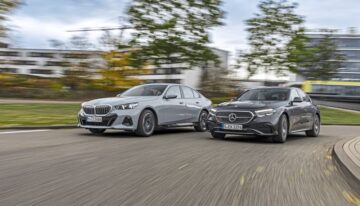Mercedes Vision SLR was presented at Detroit Auto Show in January 1999 as “Tomorrow’s Silver Arrow”. The concept was transformed in Mercedes SLR McLaren an entered in series production in 2004.
In January 1999, Mercedes present Vision SLR at Detroit Auto Show as “Tomorrow Silver Arrow”. Designed as a Gran Turismo for the 21 st century, Vision SLR incporporates design elements from the Silver Arrow Formula 1 race cars of that times and from the SLR sport cars of the 1950s.
The front part with the V-shaped nose and the clear twin-airfoil design – an element which was repeated also in other points on the body and on the interior – was inspired by the Formula 1 race cars. The long and extende bonnet, the gullwing doors and the powerfully sculpted fenders are reminiscent of the design ideas from the legendary SL models of the 1950s and their SLR racing versions.
The chassis was made from fibre composites and aluminium which save 40% of the weight compared with a conventional steel designs. Mercedes introduced also the Sensotronic Brake Control (SBC), an electrohydraulic brake system which debut later in SL (R230) in 2001 and bi-xenon headlamps with Active Light System which started in E-Class (W211) in 2003. If Active Light System was a big success, the Sensotronic Brake Control was not reliable and Mercedes took out the system from series production. The final series production Vision SLR used a classic brake system with fibre reinforced ceramic.
Vision SLR was powered by the AMG 5.5 litre V8 engine supercharged with a mechanical compressor which deliver 557 HP and 720 Nm at 4,000 rpm, meanwhile 580 Nm were available already from 2,000 rpm. The engine was mated with a 5-speed automatic gearbox with Touchshift control. Vision SLR accelerates from 0 to 100 km/h in 4.2 seconds and reach a maximum speed 320 km/h.
Later at Frankfurt motorshow in autumn 1999, Mercedes presented also the Vision SLR roadster which featured a textile roof and classic doors.
To industrialize the concept, Mercedes decided to make a partnership with McLaren which was partner with Mercedes-Benz in that years in Formula 1.
But Mclaren and Mercedes-Benz are two completely different worlds and completely different cultures. Mercedes wants a sport car which must respect traditional Mercedes requirements regarding safety and comfort. On the other side, McLaren want a pure sports car. The result was not in the end a hypersports car but a powerful Gran Turismo with a comfortable rear suspension and a front sport suspension. The series production engine delivered 626 HP/6,500 rpm and 780 Nm between 3,250 and 5,000 rpm. Mercedes SLR Mclaren accelerates from 0 to 100 km/h in 3.6 seconds and reach a maximum speed of 334 km/h.
The car enetered in production in 2004 at a price of around 450,000 euros almost the same like the Porsche Carrera GT which was released in the same time. Mercedes and Mclaren planned to sell 3,500 units – 500 units each along 7 years. But even including the roadster version and also the special versions, the final production figures did not reach the original plans. But despite this situation, Mercedes SLR McLaren remain the best selling hypercar from the history.
After ceasing production in 2009 and stopping the cooperation with Mclaren, Mercedes decide to go on its own and to give the freedom to its AMG division to develop its own cars.
In 2009, Mercedes-AMG presented SLS AMG, the first own designed car by AMG which cost less than half of the price of the SLR McLaren despite ther fact the SLS AMG preserved the expensive to produce gullwing doors. With 189,000 euro, SLS AMG was a bargain compared with SLR. And it was very successful because Mercedes succeed to sell almost 6,000 units together with the roadster version with textile roof and classic doors in the whole lifecycle.




















